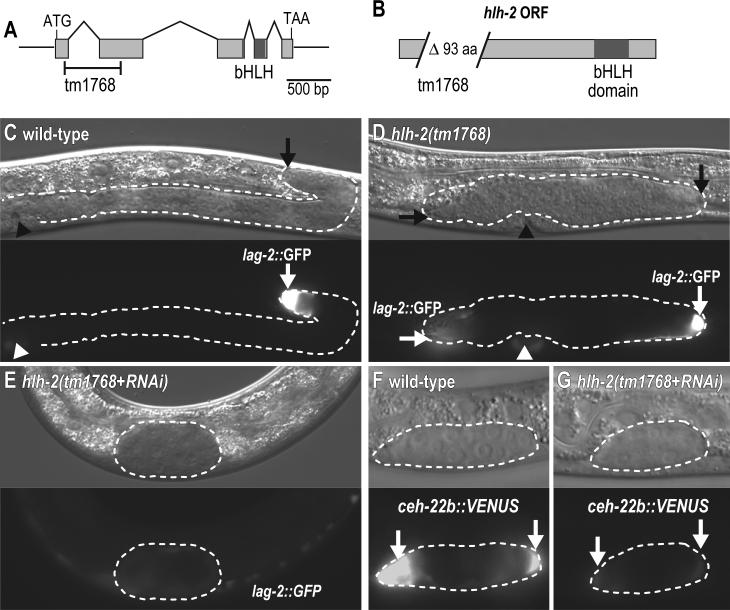Fig. 2.
Strong HLH-2 reduction in a hlh-2 mutant treated with hlh-2 RNAi. (A) The hlh-2 locus. Boxes, exons; lines, introns; region encoding bHLH DNA-binding domain, dark grey. Bracketed region is deleted in hlh-2(tm1768) deletion/insertion allele. (B) The HLH-2 ORF. The predicted hlh-2(tm1768) protein harbors a 93 aa deletion and six amino acid insertion of novel sequence in the N-terminal region. (C-G) Animals grown at 25°C. Anterior, left. Dorsal, up. Top, Nomarski; bottom, fluorescence; dotted lines, outline of gonad; arrows, hDTCs. (C-E) L4 hermaphrodites carrying lag-2::GFP, qIs57. Arrowhead, vulva. Exposure times: (C) and (D), 4 ms, (E) 20 ms. (C) Wild-type gonad is elongated and reflexed. lag-2::GFP is bright in the hDTC. (D) hlh-2(tm1768) gonad extends slightly but fails to reflex. lag-2::GFP is bright in the hDTCs. Left hDTC is out of the focal plane, but GFP is still visible. (E) hlh-2(tm1768) treated with hlh-2 RNAi. Gonad is not elongated or reflexed; no hDTCs are present. A faint lag-2::GFP signal can be detected in the somatic gonad when exposed for 20 ms; signal was barely detectable when exposed for 4 ms, which was the exposure time used in (C) and (D) (not shown). (F, G) L2 hermaphrodites carrying ceh-22b::VENUS reporter, qIs90. (F) Wild-type larva treated for RNAi but on empty vector. ceh-22b::VENUS is bright in the hDTCs. (G) hlh-2(tm1768) mutant treated with hlh-2 RNAi. ceh-22b::VENUS is barely detectable.

